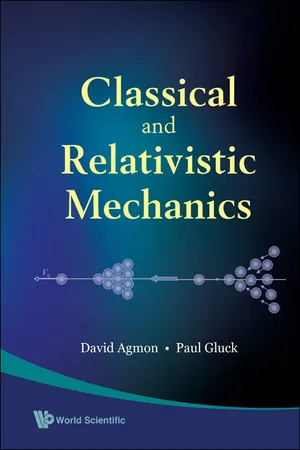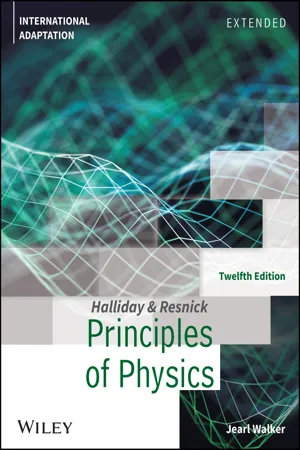Physics
Displacement, Time and Average Velocity
Displacement refers to the change in position of an object, while time measures the duration of an event. Average velocity is the displacement of an object divided by the time taken, indicating the overall rate of change in position. These concepts are fundamental in understanding the motion and behavior of objects in the field of physics.
Written by Perlego with AI-assistance
Related key terms
1 of 5
10 Key excerpts on "Displacement, Time and Average Velocity"
- eBook - PDF
- William Moebs, Samuel J. Ling, Jeff Sanny(Authors)
- 2016(Publication Date)
- Openstax(Publisher)
As it travels, say, from Tokyo to Kyoto, it is at different positions along the track at various times in its journey, and therefore has displacements, or changes in position. It also has a variety of velocities along its path and it undergoes accelerations (changes in velocity). With the skills learned in this chapter we can calculate these quantities and average velocity. All these quantities can be described using kinematics, without knowing the train’s mass or the forces involved. Chapter 3 | Motion Along a Straight Line 105 3.1 | Position, Displacement, and Average Velocity Learning Objectives By the end of this section, you will be able to: • Define position, displacement, and distance traveled. • Calculate the total displacement given the position as a function of time. • Determine the total distance traveled. • Calculate the average velocity given the displacement and elapsed time. When you’re in motion, the basic questions to ask are: Where are you? Where are you going? How fast are you getting there? The answers to these questions require that you specify your position, your displacement, and your average velocity—the terms we define in this section. Position To describe the motion of an object, you must first be able to describe its position (x): where it is at any particular time. More precisely, we need to specify its position relative to a convenient frame of reference. A frame of reference is an arbitrary set of axes from which the position and motion of an object are described. Earth is often used as a frame of reference, and we often describe the position of an object as it relates to stationary objects on Earth. For example, a rocket launch could be described in terms of the position of the rocket with respect to Earth as a whole, whereas a cyclist’s position could be described in terms of where she is in relation to the buildings she passes Figure 3.2. - eBook - PDF
- David Halliday, Robert Resnick, Jearl Walker(Authors)
- 2018(Publication Date)
- Wiley(Publisher)
13 C H A P T E R 2 Motion Along a Straight Line 2-1 POSITION, DISPLACEMENT, AND AVERAGE VELOCITY What Is Physics? One purpose of physics is to study the motion of objects—how fast they move, for example, and how far they move in a given amount of time. NASCAR engineers are fanatical about this aspect of physics as they determine the performance of their cars before and during a race. Geologists use this physics to measure tectonic-plate motion as they attempt to predict earthquakes. Medical researchers need this physics to map the blood flow through a patient when diagnosing a par- tially closed artery, and motorists use it to determine how they might slow suf- ficiently when their radar detector sounds a warning. There are countless other examples. In this chapter, we study the basic physics of motion where the object (race car, tectonic plate, blood cell, or any other object) moves along a single axis. Such motion is called one-dimensional motion. Key Ideas ● The position x of a particle on an x axis locates the par- ticle with respect to the origin, or zero point, of the axis. ● The position is either positive or negative, according to which side of the origin the particle is on, or zero if the particle is at the origin. The positive direction on an axis is the direction of increasing positive numbers; the opposite direction is the negative direction on the axis. ● The displacement Δx of a particle is the change in its position: Δx = x 2 − x 1 . ● Displacement is a vector quantity. It is positive if the particle has moved in the positive direction of the x axis and negative if the particle has moved in the negative direction. ● When a particle has moved from position x 1 to position x 2 during a time interval Δt = t 2 − t 1 , its average velocity during that interval is v avg = Δx Δt = x 2 − x 1 t 2 − t 1 . ● The algebraic sign of v avg indicates the direction of motion (v avg is a vector quantity). - eBook - PDF
- Michael Tammaro(Author)
- 2019(Publication Date)
- Wiley(Publisher)
Additional Example Velocity, Displacement, Distance, and Speed 2.3 Calculate the average velocity over shorter and shorter time intervals to estimate the instantaneous velocity. 2.3 INSTANTANEOUS VELOCITY Learning Objective Suppose that it takes Mary 17.0 min (0.283 h) to drive southwest along the straight, 4.20-km stretch of Park Avenue along the east side of Central Park in Manhattan. Defining south- west to be the positive direction, her average velocity is v x t 4.20 km 0.283 h 14.8 km h avg / = ∆ ∆ = = + Due to traffic signals and traffic congestion, though, it’s quite unlikely that the speedometer reading of her car is exactly 14.8 km/h for the duration of the trip. Thus, her average velo- city does not reveal any information about her car’s instantaneous velocity at various times throughout the trip. If she wants to know how fast her car is moving at a particular instant during this drive, it would make sense to measure the average velocity over a very small time interval that contains 50 | Chapter 2 this particular instant. After all, over a very short time interval it is unlikely that the car’s velocity will change significantly. As a result, we define the instantaneous velocity as follows: v x t lim t 0 = ∆ ∆ ∆ → (2.3.1) The notation lim t 0 ∆ → is an abbreviation for “the limit as delta t approaches zero.” It means that you should calculate the displacement x ∆ for smaller and smaller values of t ∆ . As t ∆ gets smaller, so does x ∆ , but the ratio x t / ∆ ∆ approaches a well-defined limit. This limit is the instantaneous velocity. Practice Problem 2.3.1 illustrates this limiting process. Hence- forth, when we refer to an object’s velocity, we mean its instantaneous velocity, with the magnitude of the instantaneous velocity being the object’s (instantaneous) speed. 2.4 Solve problems involving average acceleration, velocity, and time. 2.4.1 Interpret or determine the direction of the acceleration. - eBook - PDF
- John D. Cutnell, Kenneth W. Johnson, David Young, Shane Stadler(Authors)
- 2015(Publication Date)
- Wiley(Publisher)
26 erniedecker/iStockphoto 2.2 | Speed and Velocity 27 direction is assigned a negative value. For instance, assume that a car is moving along an east/west direction and that a positive (1) sign is used to denote a direction due east. Then, D x B 5 1500 m represents a displacement that points to the east and has a magnitude of 500 meters. Conversely, D x B 5 2500 m is a displacement that has the same magnitude but points in the opposite direction, due west. The magnitude of the displacement vector is the shortest distance between the ini- tial and final positions of the object. However, this does not mean that displacement and distance are the same physical quantities. In Figure 2.1, for example, the car could reach its final position after going forward and backing up several times. In that case, the total distance traveled by the car would be greater than the magnitude of the displacement vector. Check Your Understanding (The answer is given at the end of the book.) 1. A honeybee leaves the hive and travels a total distance of 2 km before returning to the hive. What is the magnitude of the displacement vector of the bee? 2.2 | Speed and Velocity Average Speed One of the most obvious features of an object in motion is how fast it is moving. If a car travels 200 meters in 10 seconds, we say its average speed is 20 meters per second, the av- erage speed being the distance traveled divided by the time required to cover the distance: Average speed 5 Distance Elapsed time (2.1) Equation 2.1 indicates that the unit for average speed is the unit for distance divided by the unit for time, or meters per second (m/s) in SI units. Example 1 illustrates how the idea of average speed is used. EXAMPLE 1 | Distance Run by a Jogger How far does a jogger run in 1.5 hours (5400 s) if his average speed is 2.22 m/s? Reasoning The average speed of the jogger is the average distance per second that he travels. - eBook - PDF
- John D. Cutnell, Kenneth W. Johnson, David Young, Shane Stadler(Authors)
- 2018(Publication Date)
- Wiley(Publisher)
However, all of the questions are available for assignment via WileyPLUS. Section 2.1 Displacement 1. What is the difference between distance and displacement? (a) Distance is a vector, while displacement is not a vector. (b) Displacement is a vector, while distance is not a vector. (c) There is no difference between the two concepts; they may be used interchangeably. Section 2.2 Speed and Velocity 3. A jogger runs along a straight and level road for a distance of 8.0 km and then runs back to her starting point. The time for this round-trip is 2.0 h. Which one of the following statements is true? (a) Her average speed is 8.0 km/h, but there is not enough information to determine her average velocity. (b) Her average speed is 8.0 km/h, and her average velocity is 8.0 km/h. (c) Her average speed is 8.0 km/h, and her average velocity is 0 km/h. Section 2.3 Acceleration 6. The velocity of a train is 80.0 km/h, due west. One and a half hours later its velocity is 65.0 km/h, due west. What is the train’s average acceleration? (a) 10.0 km/h 2 , due west (b) 43.3 km/h 2 , due west (c) 10.0 km/h 2 , due east (d) 43.3 km/h 2 , due east (e) 53.3 km/h 2 , due east. Section 2.4 Equations of Kinematics for Constant Acceleration 10. In which one of the following situations can the equations of kinematics not be used? (a) When the velocity changes from moment to moment, (b) when the velocity remains constant, (c) when the acceleration changes from moment to moment, (d) when the acceleration remains constant. 13. In a race two horses, Silver Bullet and Shotgun, start from rest and each maintains a constant acceleration. In the same elapsed time Silver Bullet runs 1.20 times farther than Shotgun. - eBook - PDF
- David Halliday, Robert Resnick, Jearl Walker(Authors)
- 2021(Publication Date)
- Wiley(Publisher)
Displacement If a particle moves so that its position vector changes from r → 1 to r → 2 , the particle’s displacement Δ r → is Δ r → = r → 2 − r → 1 . (4.1.2) The displacement can also be written as Δ r → = ( x 2 − x 1 ) ˆ i + ( y 2 − y 1 ) ˆ j + ( z 2 − z 1 )k ̂ (4.1.3) = Δx ˆ i + Δy ˆ j + Δz k ̂ . (4.1.4) Average Velocity and Instantaneous Velocity If a particle undergoes a displacement Δ r → in time interval Δt, its average velocity v → avg for that time interval is v → avg = Δ r → ____ Δt . (4.2.1) As ∆t in Eq. 4.2.1 is shrunk to 0, v → avg reaches a limit called either the velocity or the instantaneous velocity v → : v → = d r → ___ dt , (4.2.3) which can be rewritten in unit-vector notation as v → = v x ˆ i + v y ˆ j + v z k ̂ , (4.2.4) where v x = dx /dt, v y = dy/dt, and v z = dz /dt. The instantaneous velocity v → of a particle is always directed along the tangent to the particle’s path at the particle’s position. Average Acceleration and Instantaneous Accele- ration If a particle’s velocity changes from v → 1 to v → 2 in time interval ∆t, its average acceleration during ∆t is a → avg = v → 2 − v → 1 ________ Δt = Δ v → ____ Δt . (4.3.1) As ∆t in Eq. 4.3.1 is shrunk to 0, a → avg reaches a limiting value called either the acceleration or the instantaneous acceleration a → : a → = d v → ___ dt . (4.3.2) In unit-vector notation, a → = a x ˆ i + a y ˆ j + a z k ̂ , (4.3.3) where a x = dv x /dt, a y = dv y /dt, and a z = dv z /dt. Review & Summary Projectile Motion Projectile motion is the motion of a par- ticle that is launched with an initial velocity v → 0 . During its flight, the particle’s horizontal acceleration is zero and its vertical acceleration is the free-fall acceleration ‒g. - eBook - PDF
- David Agmon, Paul Gluck;;;(Authors)
- 2009(Publication Date)
- WSPC(Publisher)
(c) By the vector r, with tail at O and tip at P. The dotted line in the diagram is the time-dependent path of a particle. At time t the particle is at P located by the (position) vector /i, at a later time t 2 it is at P 2 given by the vector r 2 . The displacement vector r 2 starts from Pi and ends at P 2 , and is given by r 2 i=r 2 -r 1 as shown. We denote r 21 by Ar . Pi ^21=^2-^1 25 26 Classical and Relativistic Mechanics Note that displacement is a vector, and that its magnitude is usually smaller than the distance traveled S: Ar < S . (S is a scalar). The choice of origin changes T and r 2 , but not r 2 . As the particle moves in time its position vector r(t) is time-dependent, but for simplicity we shall often omit writing this explicitly. 2.2 Motion along a straight line, average and constant velocity There are two good reasons to justify treating one-dimensional motion first. First, it is technically simpler. More important, the general vector equations describing three-dimensional motion may be decomposed into three equations for the components, one in each dimension, so that formally the body executes three independent one-dimensional motions. Consider motion of a particle along the x-axis. Let x, x 2 be its position at time t and a later time t 2 , respectively. The time elapsed is At = t 2 - t h while the displacement is Ax = x 2 - x x . The average velocity V in the interval is defined as V=Ax/At (2.1) The bar over a symbol of any physical u Ax quantity denotes its average value. Actually, in one-dimensional motion we may dispense with the vector notation and replace X by x, and so on. A more formal definition of average velocity, involving the explicit dependence of the velocity on time, V(t), is At Jo At Choosing in (2.1) t = 0, t 2 -/andxi =x 0 , x 2 = x, we get y = ^ Z ^ => X = x n +Vt (2.2) t-0 ° This equation gives the position of the body as function of time. - David Halliday, Robert Resnick, Jearl Walker(Authors)
- 2023(Publication Date)
- Wiley(Publisher)
(4.2.2) For example, if a particle moves through displacement (12 m) ˆ i + (3.0 m)k ̂ in 2.0 s, then its average velocity during that move is v → avg = Δ r → ____ Δt = (12 m) ˆ i + (3.0 m)k ̂ _________________ 2.0 s = (6.0 m / s) ˆ i + (1.5 m / s)k ̂ . That is, the average velocity (a vector quantity) has a component of 6.0 m/s along the x axis and a component of 1.5 m/s along the z axis. When we speak of the velocity of a particle, we usually mean the particle’s instantaneous velocity v → at some instant. This v → is the value that v → avg approaches 4.2 Average Velocity and Instantaneous Velocity 65 FIGURE 4.2.1 The displacement Δ r → of a parti- cle during a time interval Δt, from position 1 with position vector r → 1 at time t 1 to position 2 with position vector r → 2 at time t 2 . The tangent to the particle’s path at position 1 is shown. r 1 r 2 Path Tangent O y x 1 2 r As the particle moves, the position vector must change. This is the displacement. Δ in the limit as we shrink the time interval Δt to 0 about that instant. Using the language of calculus, we may write v → as the derivative v → = d r → ___ dt . (4.2.3) Figure 4.2.1 shows the path of a particle that is restricted to the xy plane. As the particle travels to the right along the curve, its position vector sweeps to the right. During time interval Δt, the position vector changes from r → 1 to r → 2 and the particle’s displacement is Δ r → . To find the instantaneous velocity of the particle at, say, instant t 1 (when the particle is at position 1), we shrink interval Δt to 0 about t 1 . Three things hap- pen as we do so. (1) Position vector r → 2 in Fig. 4.2.1 moves toward r → 1 so that Δ r → shrinks toward zero. (2) The direction of Δ r → / Δt (and thus of v → avg ) approaches the direction of the line tangent to the particle’s path at position 1. (3) The average velocity v → avg approaches the instantaneous velocity v → at t 1 .- eBook - PDF
- John D. Cutnell, Kenneth W. Johnson, David Young, Shane Stadler(Authors)
- 2015(Publication Date)
- Wiley(Publisher)
(See Sections 1.5 and 1.6 for a review of vectors and vector addition.) This means that r B 5 r B 0 1 D r B , or Displacement 5 D r B 5 r B 2 r B 0 The displacement here is defined as it is in Chapter 2. Now, however, the displacement vector may lie anywhere in a plane, rather than just along a straight line. The average velocity v B of the car in Figure 3.1 between the two positions is defined in a manner similar to that in Equation 2.2, as the displacement D r B 5 r B 2 r B 0 divided by the elapsed time Dt 5 t 2 t 0 : v B 5 r B 2 r B 0 t 2 t 0 5 D r B Dt (3.1) Since both sides of Equation 3.1 must agree in direction, the average velocity vector has the same direction as the displacement D r B . The velocity of the car at an instant of time is its instantaneous velocity v B . The average velocity becomes equal to the instantaneous velocity v B in the limit that Dt becomes infinitesimally small (Dt B 0 s): v B 5 lim Dt B0 D r B D t Figure 3.2 illustrates that the instantaneous velocity v B is tangent to the path of the car. The drawing also shows the vector components v B x and v B y of the velocity, which are parallel to the x and y axes, respectively. +y +x r 0 r Δr t 0 t Figure 3.1 The displacement D r B of the car is a vector that points from the initial position of the car at time t 0 to the final position at time t. The magnitude of D r B is the shortest distance between the two positions. 3 | Kinematics in Two Dimensions © threespeedjones/iStockphoto 49 50 Chapter 3 | Kinematics in Two Dimensions +y +x v y v x θ v Figure 3.2 The instantaneous velocity v B and its two vector components v B x and v B y . The average acceleration a B is defined just as it is for one-dimensional motion— namely, as the change in velocity, Dv B 5 v B 2 v 0 B , divided by the elapsed time Dt: a B 5 v B 2 v B 0 t 2 t 0 5 Dv B D t (3.2) The average acceleration has the same direction as the change in velocity D v B . - eBook - PDF
- David Halliday, Robert Resnick, Jearl Walker(Authors)
- 2020(Publication Date)
- Wiley(Publisher)
Using Eq. 4-4, we can write Eq. 4-8 in vector components as v → avg = Δxi ˆ + Δyj ˆ + Δzk ˆ Δt = Δx Δt i ˆ + Δy Δt j ˆ + Δz Δt k ˆ . (4-9) For example, if a particle moves through displacement (12 m)i ˆ + (3.0 m)k ˆ in 2.0 s, then its average velocity during that move is v → avg = Δ r → Δt = (12 m)i ˆ + (3.0 m)k ˆ 2.0 s = (6.0 m/s)i ˆ + (1.5 m/s)k ˆ . That is, the average velocity (a vector quantity) has a component of 6.0 m/s along the x axis and a component of 1.5 m/s along the z axis. When we speak of the velocity of a particle, we usually mean the particle’s instantaneous velocity v → at some instant. This v → is the value that v → avg approaches in the limit as we shrink the time interval Δt to 0 about that instant. Using the language of calculus, we may write v → as the derivative v → = d r → dt . (4-10) Figure 4-3 shows the path of a particle that is restricted to the xy plane. As the particle travels to the right along the curve, its position vector sweeps to the right. During time interval Δt, the position vector changes from r → 1 to r → 2 and the particle’s displacement is Δ r → . To find the instantaneous velocity of the particle at, say, instant t 1 (when the particle is at position 1), we shrink interval Δt to 0 about t 1 . Three things hap- pen as we do so. (1) Position vector r → 2 in Fig. 4-3 moves toward r → 1 so that Δ r → Figure 4-3 The displacement Δ r → of a particle during a time interval Δt, from position 1 with position vector r → 1 at time t 1 to position 2 with position vector r → 2 at time t 2 . The tangent to the particle’s path at position 1 is shown. r 1 r 2 Path Tangent O y x 1 2 r Δ As the particle moves, the position vector must change. This is the displacement. 57 shrinks toward zero. (2) The direction of Δ r → /Δt (and thus of v → avg ) approaches the direction of the line tangent to the particle’s path at position 1. (3) The average velocity v → avg approaches the instantaneous velocity v → at t 1 .
Index pages curate the most relevant extracts from our library of academic textbooks. They’ve been created using an in-house natural language model (NLM), each adding context and meaning to key research topics.









